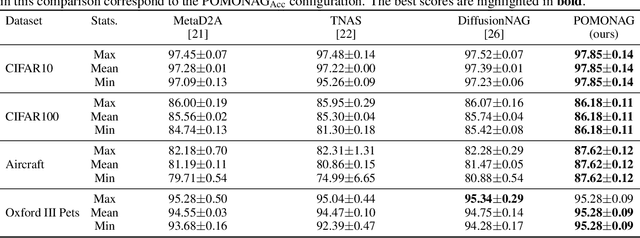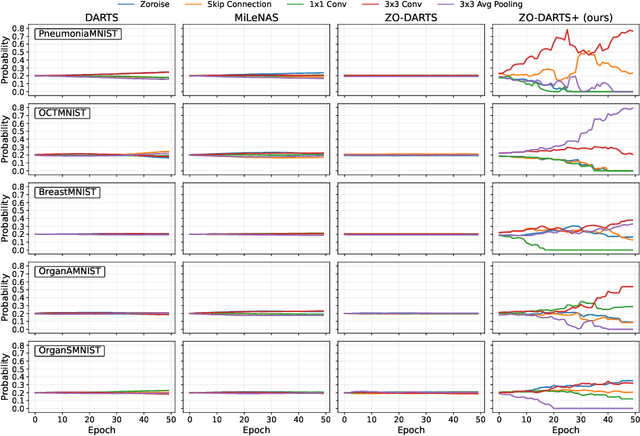Eugenio Lomurno
Your Image Generator Is Your New Private Dataset
Apr 08, 2025Abstract:Generative diffusion models have emerged as powerful tools to synthetically produce training data, offering potential solutions to data scarcity and reducing labelling costs for downstream supervised deep learning applications. However, effectively leveraging text-conditioned image generation for building classifier training sets requires addressing key issues: constructing informative textual prompts, adapting generative models to specific domains, and ensuring robust performance. This paper proposes the Text-Conditioned Knowledge Recycling (TCKR) pipeline to tackle these challenges. TCKR combines dynamic image captioning, parameter-efficient diffusion model fine-tuning, and Generative Knowledge Distillation techniques to create synthetic datasets tailored for image classification. The pipeline is rigorously evaluated on ten diverse image classification benchmarks. The results demonstrate that models trained solely on TCKR-generated data achieve classification accuracies on par with (and in several cases exceeding) models trained on real images. Furthermore, the evaluation reveals that these synthetic-data-trained models exhibit substantially enhanced privacy characteristics: their vulnerability to Membership Inference Attacks is significantly reduced, with the membership inference AUC lowered by 5.49 points on average compared to using real training data, demonstrating a substantial improvement in the performance-privacy trade-off. These findings indicate that high-fidelity synthetic data can effectively replace real data for training classifiers, yielding strong performance whilst simultaneously providing improved privacy protection as a valuable emergent property. The code and trained models are available in the accompanying open-source repository.
Neuro-Symbolic Scene Graph Conditioning for Synthetic Image Dataset Generation
Mar 21, 2025Abstract:As machine learning models increase in scale and complexity, obtaining sufficient training data has become a critical bottleneck due to acquisition costs, privacy constraints, and data scarcity in specialised domains. While synthetic data generation has emerged as a promising alternative, a notable performance gap remains compared to models trained on real data, particularly as task complexity grows. Concurrently, Neuro-Symbolic methods, which combine neural networks' learning strengths with symbolic reasoning's structured representations, have demonstrated significant potential across various cognitive tasks. This paper explores the utility of Neuro-Symbolic conditioning for synthetic image dataset generation, focusing specifically on improving the performance of Scene Graph Generation models. The research investigates whether structured symbolic representations in the form of scene graphs can enhance synthetic data quality through explicit encoding of relational constraints. The results demonstrate that Neuro-Symbolic conditioning yields significant improvements of up to +2.59% in standard Recall metrics and +2.83% in No Graph Constraint Recall metrics when used for dataset augmentation. These findings establish that merging Neuro-Symbolic and generative approaches produces synthetic data with complementary structural information that enhances model performance when combined with real data, providing a novel approach to overcome data scarcity limitations even for complex visual reasoning tasks.
ZO-DARTS++: An Efficient and Size-Variable Zeroth-Order Neural Architecture Search Algorithm
Mar 08, 2025Abstract:Differentiable Neural Architecture Search (NAS) provides a promising avenue for automating the complex design of deep learning (DL) models. However, current differentiable NAS methods often face constraints in efficiency, operation selection, and adaptability under varying resource limitations. We introduce ZO-DARTS++, a novel NAS method that effectively balances performance and resource constraints. By integrating a zeroth-order approximation for efficient gradient handling, employing a sparsemax function with temperature annealing for clearer and more interpretable architecture distributions, and adopting a size-variable search scheme for generating compact yet accurate architectures, ZO-DARTS++ establishes a new balance between model complexity and performance. In extensive tests on medical imaging datasets, ZO-DARTS++ improves the average accuracy by up to 1.8\% over standard DARTS-based methods and shortens search time by approximately 38.6\%. Additionally, its resource-constrained variants can reduce the number of parameters by more than 35\% while maintaining competitive accuracy levels. Thus, ZO-DARTS++ offers a versatile and efficient framework for generating high-quality, resource-aware DL models suitable for real-world medical applications.
POMONAG: Pareto-Optimal Many-Objective Neural Architecture Generator
Sep 30, 2024



Abstract:Neural Architecture Search (NAS) automates neural network design, reducing dependence on human expertise. While NAS methods are computationally intensive and dataset-specific, auxiliary predictors reduce the models needing training, decreasing search time. This strategy is used to generate architectures satisfying multiple computational constraints. Recently, Transferable NAS has emerged, generalizing the search process from dataset-dependent to task-dependent. In this field, DiffusionNAG is a state-of-the-art method. This diffusion-based approach streamlines computation, generating architectures optimized for accuracy on unseen datasets without further adaptation. However, by focusing solely on accuracy, DiffusionNAG overlooks other crucial objectives like model complexity, computational efficiency, and inference latency -- factors essential for deploying models in resource-constrained environments. This paper introduces the Pareto-Optimal Many-Objective Neural Architecture Generator (POMONAG), extending DiffusionNAG via a many-objective diffusion process. POMONAG simultaneously considers accuracy, number of parameters, multiply-accumulate operations (MACs), and inference latency. It integrates Performance Predictor models to estimate these metrics and guide diffusion gradients. POMONAG's optimization is enhanced by expanding its training Meta-Dataset, applying Pareto Front Filtering, and refining embeddings for conditional generation. These enhancements enable POMONAG to generate Pareto-optimal architectures that outperform the previous state-of-the-art in performance and efficiency. Results were validated on two search spaces -- NASBench201 and MobileNetV3 -- and evaluated across 15 image classification datasets.
Federated Knowledge Recycling: Privacy-Preserving Synthetic Data Sharing
Jul 30, 2024Abstract:Federated learning has emerged as a paradigm for collaborative learning, enabling the development of robust models without the need to centralise sensitive data. However, conventional federated learning techniques have privacy and security vulnerabilities due to the exposure of models, parameters or updates, which can be exploited as an attack surface. This paper presents Federated Knowledge Recycling (FedKR), a cross-silo federated learning approach that uses locally generated synthetic data to facilitate collaboration between institutions. FedKR combines advanced data generation techniques with a dynamic aggregation process to provide greater security against privacy attacks than existing methods, significantly reducing the attack surface. Experimental results on generic and medical datasets show that FedKR achieves competitive performance, with an average improvement in accuracy of 4.24% compared to training models from local data, demonstrating particular effectiveness in data scarcity scenarios.
Synthetic Image Learning: Preserving Performance and Preventing Membership Inference Attacks
Jul 22, 2024Abstract:Generative artificial intelligence has transformed the generation of synthetic data, providing innovative solutions to challenges like data scarcity and privacy, which are particularly critical in fields such as medicine. However, the effective use of this synthetic data to train high-performance models remains a significant challenge. This paper addresses this issue by introducing Knowledge Recycling (KR), a pipeline designed to optimise the generation and use of synthetic data for training downstream classifiers. At the heart of this pipeline is Generative Knowledge Distillation (GKD), the proposed technique that significantly improves the quality and usefulness of the information provided to classifiers through a synthetic dataset regeneration and soft labelling mechanism. The KR pipeline has been tested on a variety of datasets, with a focus on six highly heterogeneous medical image datasets, ranging from retinal images to organ scans. The results show a significant reduction in the performance gap between models trained on real and synthetic data, with models based on synthetic data outperforming those trained on real data in some cases. Furthermore, the resulting models show almost complete immunity to Membership Inference Attacks, manifesting privacy properties missing in models trained with conventional techniques.
A Lightweight Neural Architecture Search Model for Medical Image Classification
May 06, 2024

Abstract:Accurate classification of medical images is essential for modern diagnostics. Deep learning advancements led clinicians to increasingly use sophisticated models to make faster and more accurate decisions, sometimes replacing human judgment. However, model development is costly and repetitive. Neural Architecture Search (NAS) provides solutions by automating the design of deep learning architectures. This paper presents ZO-DARTS+, a differentiable NAS algorithm that improves search efficiency through a novel method of generating sparse probabilities by bi-level optimization. Experiments on five public medical datasets show that ZO-DARTS+ matches the accuracy of state-of-the-art solutions while reducing search times by up to three times.
Stable Diffusion Dataset Generation for Downstream Classification Tasks
May 04, 2024

Abstract:Recent advances in generative artificial intelligence have enabled the creation of high-quality synthetic data that closely mimics real-world data. This paper explores the adaptation of the Stable Diffusion 2.0 model for generating synthetic datasets, using Transfer Learning, Fine-Tuning and generation parameter optimisation techniques to improve the utility of the dataset for downstream classification tasks. We present a class-conditional version of the model that exploits a Class-Encoder and optimisation of key generation parameters. Our methodology led to synthetic datasets that, in a third of cases, produced models that outperformed those trained on real datasets.
Age Group Discrimination via Free Handwriting Indicators
Sep 29, 2023Abstract:The growing global elderly population is expected to increase the prevalence of frailty, posing significant challenges to healthcare systems. Frailty, a syndrome associated with ageing, is characterised by progressive health decline, increased vulnerability to stressors and increased risk of mortality. It represents a significant burden on public health and reduces the quality of life of those affected. The lack of a universally accepted method to assess frailty and a standardised definition highlights a critical research gap. Given this lack and the importance of early prevention, this study presents an innovative approach using an instrumented ink pen to ecologically assess handwriting for age group classification. Content-free handwriting data from 80 healthy participants in different age groups (20-40, 41-60, 61-70 and 70+) were analysed. Fourteen gesture- and tremor-related indicators were computed from the raw data and used in five classification tasks. These tasks included discriminating between adjacent and non-adjacent age groups using Catboost and Logistic Regression classifiers. Results indicate exceptional classifier performance, with accuracy ranging from 82.5% to 97.5%, precision from 81.8% to 100%, recall from 75% to 100% and ROC-AUC from 92.2% to 100%. Model interpretability, facilitated by SHAP analysis, revealed age-dependent sensitivity of temporal and tremor-related handwriting features. Importantly, this classification method offers potential for early detection of abnormal signs of ageing in uncontrolled settings such as remote home monitoring, thereby addressing the critical issue of frailty detection and contributing to improved care for older adults.
Neural Architecture Transfer 2: A Paradigm for Improving Efficiency in Multi-Objective Neural Architecture Search
Jul 03, 2023Abstract:Deep learning is increasingly impacting various aspects of contemporary society. Artificial neural networks have emerged as the dominant models for solving an expanding range of tasks. The introduction of Neural Architecture Search (NAS) techniques, which enable the automatic design of task-optimal networks, has led to remarkable advances. However, the NAS process is typically associated with long execution times and significant computational resource requirements. Once-For-All (OFA) and its successor, Once-For-All-2 (OFAv2), have been developed to mitigate these challenges. While maintaining exceptional performance and eliminating the need for retraining, they aim to build a single super-network model capable of directly extracting sub-networks satisfying different constraints. Neural Architecture Transfer (NAT) was developed to maximise the effectiveness of extracting sub-networks from a super-network. In this paper, we present NATv2, an extension of NAT that improves multi-objective search algorithms applied to dynamic super-network architectures. NATv2 achieves qualitative improvements in the extractable sub-networks by exploiting the improved super-networks generated by OFAv2 and incorporating new policies for initialisation, pre-processing and updating its networks archive. In addition, a post-processing pipeline based on fine-tuning is introduced. Experimental results show that NATv2 successfully improves NAT and is highly recommended for investigating high-performance architectures with a minimal number of parameters.
 Add to Chrome
Add to Chrome Add to Firefox
Add to Firefox Add to Edge
Add to Edge